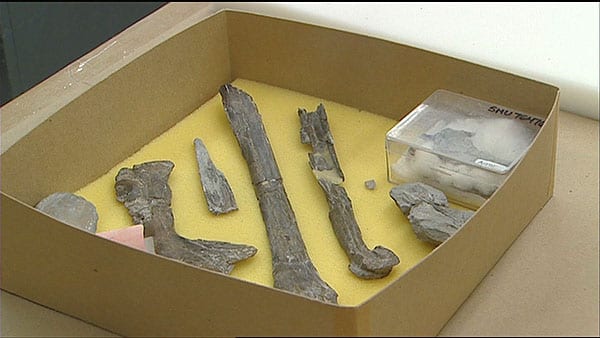WFAA-TV reporter Jonathan Betz has covered the flying reptile research of SMU paleontologist Timothy S. Myers and the rare discovery of the bones by amateur fossil hunter Gary Byrd. The story, North Texan finds dinosaurs in our backyards, aired March 17.
Myers identified fossilized bones discovered in Texas from a flying reptile that died 89 million years ago. The bones may be the world’s earliest occurrence of the prehistoric creature known as Pteranodon, Myers says.
Pteranodon was a type of pterosaur that lived about the same time as some dinosaurs, about 100 million to 65 million years ago. The only reptiles to dominate the ancient skies, pterosaurs had broad leathery wings and slim torsos.
The specimen identified by Myers had a wing span between 12 and 13 feet, or 3.6 to 4 meters. It was discovered in a rock unit that dates to early in the Late Cretaceous.
EXCERPT:
By Jonathan Betz
WFAA
Look up and you’ll see Gary Byrd on a roof. That’s where his work is.But it’s what’s underground that fascinates him.
Every free moment, the contractor roams North Texas digging in the dirt.
“When I was a kid, we’d run up and down creeks and look for stuff, and wonder what it was,” he said. “I just kept doing it, kept finding more interesting things.”
For most of his life, the 55-year-old has scoured construction sites and creek beds for dinosaur bones.
Often, he finds just dirt and rocks. But on occasion, Byrd has unearthed some truly extraordinary finds.
His treasures are enough to fill cabinets at Southern Methodist University.
“This specimen is 89 million years old,” he boasted, displaying the rare remains of a pterosaur, an ancient flying reptile that until now, had not been thought to live in Texas.
Byrd plucked the fossilized bones out of a half-built Plano subdivision.“Finding a fossil of this magnitude is a once-in-a-lifetime kind of find,” said SMU researcher Timothy Myers. “A lot of paleontologists would probably go their entire careers without finding something this significant.”
And that’s not all. Byrd has even discovered a new dinosaur species, a large duck-billed herbivore called Protohadros byrdi — yes, named after Bird himself, who found the remains near a highway.
“That really got me going,” he confessed.

